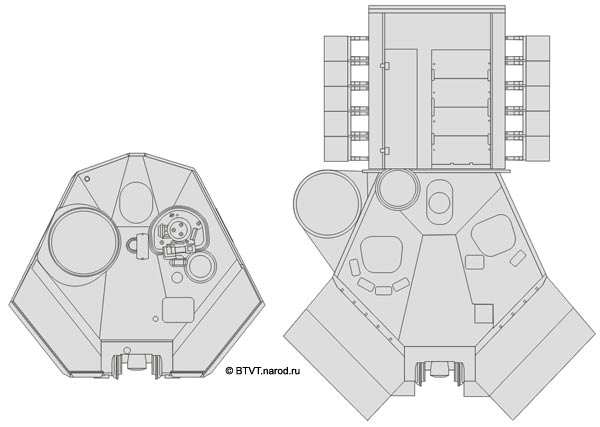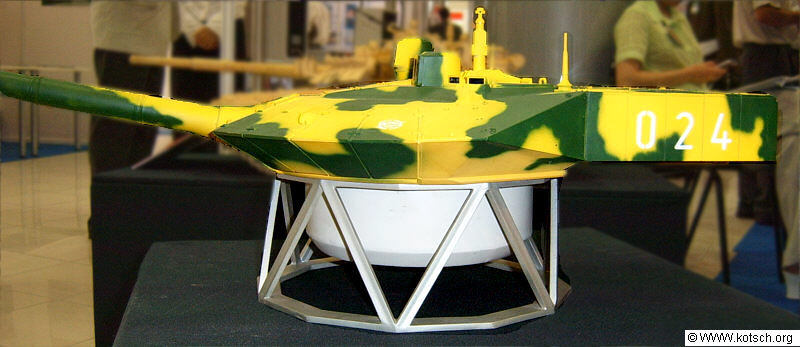The M1A1/2 Abrams main battle tank is manufactured by General Dynamics Land Systems (GDLS). The first M1 tank was produced in 1978, the M1A1 in 1985 and the M1A2 in 1986.
3,273 M1 tanks were produced for the US Army. 4,796 M1A1 tanks were built for the US Army, 221 for the US Marines and 880 co-produced with Egypt.
77 M1A2 tanks have been built for the US Army, 315 for Saudi Arabia and 218 for Kuwait. For the M1A2 upgrade programme, over 600 M1 Abrams tanks are being upgraded to M1A2 configuration. Deliveries began in 1998.
In March 2004, the Australian Army announced the purchase of 59 US Army M1A1 tanks to enter service from 2007. The contract was signed in November 2005 and the first five were handed over in February 2006 at GDLS in Lima, Ohio. The first 18 tanks were delivered to the Australian Army at the School of Armour in Victoria in September 2006. The remaining 41, to be based in Darwin, were delivered in March 2007.
In June 2006, Saudi Arabia requested the foreign military sale of 58 M1A1 tanks and the upgrade of these and the 315 M1A2 already in the Saudi inventory to M1A2S configuration. The upgrade involves rebuilding to a 'like new' condition, similar to the US Army Abrams integrated management programme (AIM).
In August 2007, Egypt requested the foreign military sale of an additional 125 M1A1 tanks, which would bring the country’s fleet to 1,005 M1A1 tanks.
In July 2008, the government of Iraq requested the sale of 140 M1A1 tanks to be upgraded to M1A1M configuration.
M1A2 system enhancement package (SEP)
In February 2001, GDLS were contracted to supply 240 M1A2 tanks with a system enhancement package (SEP) by 2004. The M1A2 SEP contains an embedded version of the US Army's Force XXI command and control architecture; new Raytheon commander's independent thermal viewer (CITV) with second-generation thermal imager; commander's display for digital colour terrain maps; DRS Techologies second-generation GEN II TIS thermal imaging gunner's sight with increased range; driver's integrated display and thermal management system.
"The army's force XXI battle command, brigade and below (FBCB2) programme is a digital battle command information system."
The US Army decided to cancel future production of the M1A2 SEP from FY2004, but in June 2005 ordered the upgraded of a further 60 M1A2 tanks to SEP configuration. A further 60 were ordered in August 2006, and 180 in November 2006.
Under the firepower enhancement package (FEP), DRS Techologies has also been awarded a contract for the GEN II TIS to upgrade US Marine Corps M1A1 tanks. GEN II TIS is based on the 480×4 SADA (standard advanced dewar assembly) detector.
The FEP also includes an eyesafe laser rangefinder, north-finding module and precision lightweight global positioning receiver which provide targeting solutions for the new far target locate (FTL) function.
FTL gives accurate targeting data to a range of 8,000m with a CEP (circular error of probability) of less than 35m.
In November 2007, General Dynamics was awarded a contract for the upgrade of 240 M1A2 SEP version one tanks to the version two configuration which has improved sights, displays and a tank-infantry phone. The first was completed in October 2008. Work is to be completed by September 2009.
In February 2008, General Dynamics was awarded a multi-year contract to upgrade to SEP Version Two (V2) configuration the remaining 435 M1A1 tanks in the US Army inventory.
FBCB2
In June 2004, DRS Technologies was awarded a contract to provide systems including rugged appliqué computers for the M1A2 Abrams tanks (and M2A3 Bradley fighting vehicles) as part of the US Army's Force XXI battle command, brigade and below (FBCB2) programme.
FBCB2 is a digital battle command information system which provides enhanced interoperability and situation awareness from brigade to individual soldier that will be used in conjunction with the Army's tactical internet.
M1 Abrams armament
The main armament is the 120mm M256 smoothbore gun, developed by Rheinmetall Waffe Munition GmbH of Germany. The 120mm gun fires the following ammunition: the M865 TPCSDS-T and M831 TP-T training rounds, the M8300 HEAT-MP-T and the M829 APFSDS-T which includes a depleted uranium penetrator. Textron Systems provides the Cadillac Gage gun turret drive stabilisation system.
The commander has a 12.7mm Browning M2 machine gun and the loader has a 7.62mm M240 machine gun. A 7.62mm M240 machine gun is also mounted coaxially on the right hand side of the main armament.
"The M1A1 tank incorporates steel-encased depleted uranium armour."
Depleted uranium armour
The M1A1 tank incorporates steel-encased depleted uranium armour. Armour bulkheads separate the crew compartment from the fuel tanks.
The top panels of the tank are designed to blow outwards in the event of penetration by a HEAT projectile. The tank is protected against nuclear, biological and chemical (NBC) warfare.
One L8A1 six-barrelled smoke grenade discharger is fitted on each side of the turret. A smoke screen can also be laid by an engine-operated system.
In August 2006, General Dynamics Land Systems was awarded a contract to produce 505 tank urban survivability kits (TUSK) for the US Army Abrams tanks. TUSK includes add-on reactive armour tiles, loader's armour gun shield (LAGS), tank infantry phone (TIP), Raytheon loader's thermal weapon sight with Rockwell Collins head-mounted display and BAE Systems thermal driver's rear-view camera (DRVC). TUSK entered service on M1A1 / M1A2 tanks in late 2007 and has been deployed to Iraq.
Australian M1A1 tanks are being fitted with Saab Barracuda multispectral camouflage systems which reduce the tank's visual, radar and infrared signature.
Fire control and observation
The commander's station is equipped with six periscopes, providing a 360° view. The Raytheon commander's independent thermal viewer (CITV) provides the commander with independent stabilised day and night vision with a 360° view, automatic sector scanning, automatic target cueing of the gunner's sight and back-up fire control.
The M1A2 Abrams tank has a two-axis Raytheon gunner's primary sight - line of sight (GPS-LOS) which increases the first round hit probability by providing faster target acquisition and improved gun pointing. The thermal imaging system (TIS) has magnification ×10 narrow field of view and ×3 wide field of view. The thermal image is displayed in the eyepiece of the gunner's sight together with the range measurement from a laser rangefinder.
The Northrop Grumman (formerly Litton) Laser Systems eyesafe laser rangefinder (ELRF) has a range accuracy to within 10m and target discrimination of 20m. The gunner also has a Kollmorgen Model 939 auxiliary sight with magnification ×8 and field of view 8°.
"The commander's station of the Abrams M1A1 is equipped with six periscopes, providing a 360° view."
The digital fire control computer is supplied by General Dynamics - Canada (formerly Computing Devices Canada).
The fire control computer automatically calculates the fire control solution based on: lead angle measurement; bend of the gun measured by the muzzle reference system; velocity measurement from a wind sensor on the roof of the turret; data from a pendulum static cant sensor located at the centre of the turret roof. The operator manually inputs data on ammunition type, temperature and barometric pressure.
The driver has either three observation periscopes or two periscopes on either side and a central image intensifying periscope for night vision. The periscopes provide 120° field of view. The DRS Technologies driver's vision enhancer (DVE), AN/VSS-5, is based on a 328×245 element uncooled infrared detector array, operating in the 7.5 to 13 micron waveband. A Raytheon driver's thermal viewer, AN/VAS-3, is installed on the M1A2 Abrams tanks for Kuwait.
Propulsion
The M1 is equipped with a Honeywell AGT 1500 gas turbine engine. The Allison X-1100-3B transmission provides four forward and two reverse gears.
The US Army has selected Honeywell International Engines and Systems and General Electric to develop a new LV100-5 gas turbine engine for the M1A2. The new engine is lighter and smaller with rapid acceleration, quieter running and no visible exhaust.















